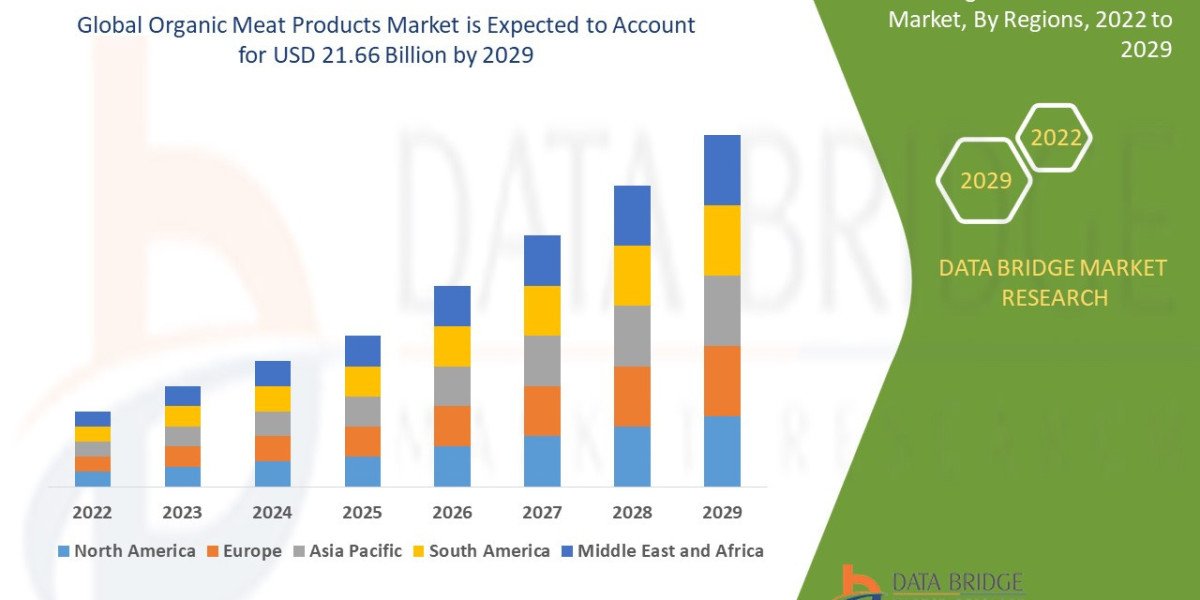Introduction
The organic meat products market has become one of the most dynamic sectors within the global food and beverages industry. Defined by its emphasis on natural, chemical-free, and ethically produced meat, this market is reshaping consumer habits, food supply chains, and agricultural practices. Organic meat refers to meat sourced from animals raised without synthetic hormones, antibiotics, or genetically modified feed, with a strong focus on sustainability, animal welfare, and ecological balance.
Globally, consumer awareness of food safety, health, and sustainability is driving unprecedented growth in this segment. As populations shift toward healthier and environmentally conscious lifestyles, organic meat has gained relevance across retail outlets, restaurants, and e-commerce platforms. With increasing regulatory support and the entry of large meat producers into the organic segment, the market continues to evolve at a steady pace.
The scope of this report covers a detailed analysis of the organic meat products market, including its overall landscape, growth drivers, restraints, segmentation, competition, and emerging trends. For stakeholders ranging from farmers to multinational food corporations, this analysis provides a roadmap to navigate opportunities and challenges in one of the fastest-growing sectors of the protein industry.
Source - https://www.databridgemarketresearch.com/reports/global-organic-meat-products-market
Market Overview
The organic meat products market includes a wide range of items such as organic beef, pork, poultry, lamb, and processed meat offerings like sausages and ready-to-cook meals. These products adhere to organic farming principles, avoiding synthetic inputs, chemical preservatives, and artificial additives. Certification standards vary by region but generally emphasize natural feed, open grazing, and humane animal treatment.
Historically, organic meat was considered a niche category, consumed primarily by health-conscious and affluent consumers. Over the last decade, however, it has moved into mainstream food markets, thanks to increasing disposable incomes, urbanization, and broader awareness of the negative impacts of conventional meat production on health and the environment.
Today, the market is witnessing strong momentum. Consumers increasingly demand transparency in food sourcing, and organic meat products address these concerns effectively. Supermarkets, specialty stores, and online platforms have expanded their organic offerings, making them more accessible to a wider audience. With rising adoption across both developed and emerging markets, the organic meat products industry is positioning itself as a significant contributor to the global protein economy.
Market Drivers and Opportunities
A key driver for the organic meat products market is growing consumer awareness of health benefits. Organic meat is often perceived as cleaner, safer, and more nutritious compared to conventionally raised meat, which may contain antibiotic residues or chemical additives. This perception has fueled demand among health-conscious consumers, particularly millennials and Generation Z, who prioritize natural and sustainable foods.
Environmental sustainability is another major driver. Conventional meat production is resource-intensive and associated with greenhouse gas emissions. In contrast, organic farming practices emphasize reduced environmental impact, biodiversity, and soil health, aligning with the values of eco-conscious consumers.
Opportunities for growth are also being shaped by the rise of premium and specialty food markets. Hotels, restaurants, and catering services are increasingly offering organic meat dishes to cater to discerning diners. The expansion of e-commerce platforms presents another opportunity, as digital channels allow direct-to-consumer sales and broader product accessibility.
Innovation in product development is opening new avenues as well. Companies are exploring ready-to-eat and value-added organic meat products such as marinated cuts, frozen meals, and organic sausages. This not only expands product offerings but also appeals to busy urban consumers seeking convenience without compromising on quality.
Emerging markets present untapped opportunities. As middle-class populations expand in Asia-Pacific, Latin America, and the Middle East, the demand for premium organic foods, including meat, is expected to grow rapidly. This creates space for local farmers, cooperatives, and global corporations to expand their footprint.
Market Challenges and Restraints
Despite its promising outlook, the organic meat products market faces several challenges. One of the most significant hurdles is the high cost of production. Organic farming requires larger land areas, longer rearing periods, and more stringent certifications, all of which raise costs. This often results in higher retail prices, limiting accessibility for cost-sensitive consumers.
Supply chain complexity also acts as a restraint. Organic meat requires strict segregation from conventional meat during processing, packaging, and distribution. Ensuring traceability and maintaining certification standards across the supply chain can be both costly and operationally challenging.
Regulatory compliance poses additional difficulties. Organic certification requirements differ across countries, creating barriers for international trade. Producers must adapt to multiple certification frameworks to expand globally, adding time and expense to market entry.
Another challenge is consumer skepticism. While demand for organic meat is growing, some consumers remain doubtful about whether organic labels truly reflect sustainable and chemical-free practices. Transparency and certification integrity are crucial to maintaining trust in this sector.
Competition from alternative proteins, including plant-based and lab-grown meat, is also emerging as a challenge. As these alternatives gain popularity for health and sustainability reasons, organic meat producers must differentiate themselves through quality, taste, and authenticity.
Market Segmentation Analysis
The organic meat products market can be segmented by product type, end-use application, distribution channel, and regional presence.
By product type, organic beef and poultry dominate demand due to their widespread consumption and versatility in cuisines globally. Organic pork and lamb hold smaller but steadily growing shares, especially in regions where these meats are culturally significant. Processed organic meat products, including sausages, patties, and ready-to-cook items, are gaining momentum as convenience becomes a priority for consumers.
By end-use application, household consumption represents the largest segment, driven by growing retail availability and consumer preference for healthier meals at home. The foodservice sector, including restaurants, hotels, and catering, is also expanding its use of organic meat to attract health-conscious customers and differentiate menus.
Distribution channels include supermarkets and hypermarkets, specialty organic stores, and online platforms. Supermarkets lead in terms of volume, offering a wide range of organic meat options to consumers. Specialty stores appeal to niche buyers seeking authenticity and premium experiences, while e-commerce platforms are becoming increasingly important, particularly in urban centers.
Regionally, North America and Europe lead the organic meat products market, driven by mature consumer awareness, established certification systems, and strong retail infrastructure. Asia-Pacific is emerging as the fastest-growing market, fueled by urbanization, rising incomes, and expanding e-commerce penetration. Latin America and the Middle East are also showing increasing demand as consumers in these regions shift toward premium and natural food choices.
Competitive Landscape
The competitive landscape of the organic meat products market includes multinational corporations, regional producers, and niche organic farms. Large global meat producers are entering the organic segment to diversify their portfolios and meet rising consumer demand. Regional players, meanwhile, leverage local farming practices and cultural preferences to establish a strong presence.
Mergers, acquisitions, and partnerships are becoming common strategies to expand product lines and distribution networks. Collaborations between farmers, cooperatives, and retailers are also playing a crucial role in strengthening supply chains and ensuring consistent quality.
Innovation is central to competition. Companies are investing in new product formats, sustainable packaging, and enhanced traceability technologies. For example, QR codes and blockchain-based solutions are being introduced to reassure consumers about product authenticity and origin.
Marketing strategies are increasingly focused on storytelling, emphasizing animal welfare, ecological benefits, and farm-to-fork transparency. This approach resonates strongly with consumers seeking not just food, but a connection to ethical and sustainable practices.
Future Outlook and Trends
The organic meat products market is expected to continue its upward trajectory over the next decade. Consumer demand for healthier, transparent, and sustainable food options will remain a cornerstone of growth. The rise of e-commerce and direct-to-consumer models will further enhance accessibility, making organic meat available to a broader audience.
Sustainability will dominate future trends, with producers exploring recyclable packaging, renewable energy in farming, and carbon-neutral supply chains. Certification bodies may also adopt stricter and more unified global standards to improve consumer confidence and facilitate international trade.
Technological advancements will shape the industry as well. From precision livestock farming to blockchain-enabled traceability, innovation will enhance efficiency, animal welfare, and transparency. Companies that integrate such technologies into their operations will hold a competitive edge.
In terms of regional hotspots, Asia-Pacific is set to emerge as a key growth region due to its expanding middle class and rising focus on food safety. Meanwhile, Europe and North America will continue to lead in innovation, product development, and sustainability initiatives.
Overall, the organic meat products market will evolve as a premium yet increasingly mainstream sector, balancing affordability, transparency, and environmental responsibility.
Conclusion
The organic meat products market is transitioning from niche to mainstream, driven by health-conscious consumers, environmental concerns, and growing global awareness of sustainable practices. While challenges such as high costs, supply chain complexity, and regulatory hurdles remain, the opportunities in innovation, e-commerce, and emerging markets are immense.
For producers, investors, and retailers, this market represents a high-potential growth avenue. Companies that prioritize transparency, sustainability, and product innovation will not only gain consumer trust but also position themselves as leaders in the evolving food landscape. The future of organic meat promises to be one of steady growth, innovation, and greater global adoption.
Frequently Asked Questions
What is the current size of the organic meat products market?
The market has grown steadily in recent years, supported by consumer demand for healthier and sustainable food. While specific figures vary by source, reports consistently project strong year-on-year growth, with the sector moving closer to mainstream adoption.
What are the key drivers influencing growth in this market?
Health awareness, environmental sustainability, and the shift toward transparent food sourcing are major drivers. The rise of e-commerce platforms and demand for premium food experiences are further accelerating market growth.
Which regions dominate the organic meat products market?
North America and Europe lead due to established certification systems, advanced retail infrastructure, and mature consumer awareness. However, Asia-Pacific is emerging as the fastest-growing region, thanks to urbanization, rising incomes, and changing dietary preferences.
Who are the major players in the industry?
The market features a mix of multinational corporations and regional producers. Global meat companies are entering the organic segment, while local farms and cooperatives are building trust through authenticity and regional relevance.
What are the latest trends shaping the future of this market?
Trends include the rise of ready-to-eat organic meat products, blockchain-based traceability, eco-friendly packaging, and sustainability-focused farming practices. Consumers are also driving demand for direct-to-consumer sales channels and greater transparency.
What challenges could slow down growth in this sector?
High production costs, supply chain complexities, and regulatory differences across regions pose challenges. Additionally, consumer skepticism and competition from plant-based and lab-grown meat alternatives could impact growth.
How can businesses benefit from investing in the organic meat products market?
Businesses that focus on innovation, sustainability, and transparent supply chains can capture strong consumer demand. Investing in e-commerce platforms, convenience-focused products, and emerging markets offers significant opportunities for long-term growth.
Browse More Reports:
Global Food Certification Market
Global Functional Food Market
Global Genetically Modified (GMO) Seeds Market
Global Heat Pumps Market
Global Immunosuppressant Market
Global Insect Protein Market
Global Instant Beverage Premix Market
Global Internet of Robotic Things (IoRT) Market
Global Liquid Biopsy Market
Global Luxury Car Leasing Market
Global Metallic Stearates Market
Global Mining Tailings Management Market
Global Organic Meat Products Market
Global Pilates Equipment Market
Global Plastic Tumblers Market
Global Processed Meat Market
Global Resistant Starch Market
Global Surface Acoustic Wave (SAW) Market
Global Surgical Lights Market
Global Treehouse Glamping Market
About Data Bridge Market Research:
An absolute way to forecast what the future holds is to comprehend the trend today!
Data Bridge Market Research set forth itself as an unconventional and neoteric market research and consulting firm with an unparalleled level of resilience and integrated approaches. We are determined to unearth the best market opportunities and foster efficient information for your business to thrive in the market. Data Bridge endeavors to provide appropriate solutions to the complex business challenges and initiates an effortless decision-making process. Data Bridge is an aftermath of sheer wisdom and experience which was formulated and framed in the year 2015 in Pune.
Contact Us:
Data Bridge Market Research
US: +1 614 591 3140
UK: +44 845 154 9652
APAC : +653 1251 975
Email:- corporatesales@databridgemarketresearch.com







